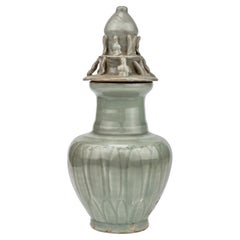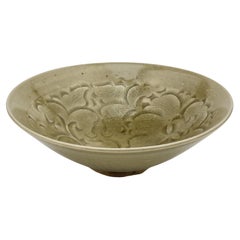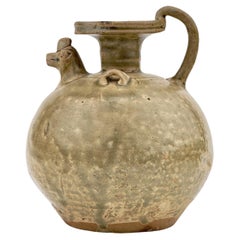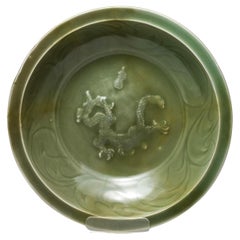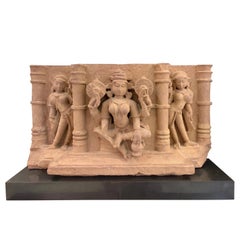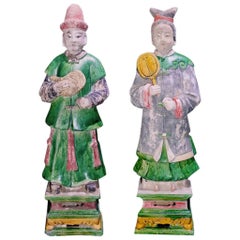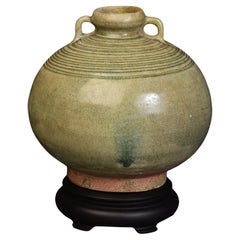Celadon Antiquities
17
to
2
2
1
17
17
17
15
1
1
95
586
525
439
271
16
15
15
1
1
Material: Celadon
Carved 'Longquan' Celadon-glazed Funerary vase and cover, Song dynasty
Located in seoul, KR
The vase features a ribbed body, subtly enhancing its graceful contours, and is topped with a uniquely sculpted lid adorned with figurative elements.
Period : Song Dynasty
Type : Ce...
Category
15th Century and Earlier Chinese Ming Antique Celadon Antiquities
Materials
Celadon
Carved 'Yaozhou' Celadon-Glazed Bowl, Song Dynasty
Located in seoul, KR
The bowl is potted with steep, flared sides and decorated to the interior with stylized peonies among scrolling tendrils. The exterior is carved with vertical lines below the everted...
Category
15th Century and Earlier Chinese Ming Antique Celadon Antiquities
Materials
Celadon
Rare Yue Celadon Chicken-Head Ewer, Jin-Southern Dynasty
Located in seoul, KR
Chicken-head ewers are among the most distinct and emblematic pottery pieces from the dynamic yet innovative era spanning from the Han (206 BC - AD 220) to the Tang (618~907) dynasti...
Category
15th Century and Earlier Chinese Han Antique Celadon Antiquities
Materials
Stoneware, Celadon
A Longquan Celadon-Glazed 'Dragon' Dish, Yuan Dynasty
Located in seoul, KR
The dish is decorated to the centre with a moulded appliqué dragon chasing the flaming pearl surrounded by a carved stylised foliage band at the cavetto. The moulded fluted exterior ...
Category
15th Century and Earlier Chinese Ming Antique Celadon Antiquities
Materials
Celadon
Small Celadon Chrysanthemum Dish, Northern Song Dynasty(AD 960~1127)
Located in seoul, KR
Potted with the fluted sides rising from a recessed base, carved to the interior with Chrysanthemum, covered overall with a grayish-green glaze, save for a ring to the underside left...
Category
15th Century and Earlier Chinese Ming Antique Celadon Antiquities
Materials
Celadon
Celadon Vase, Five Dynasties or Northern Song dynasty, 10th-11th Century
Located in seoul, KR
The form of Longquan celadon vases from the Northern Song dynasty evolved from an early design with a long neck and tapering body to a later ovoid body with a shorter neck. Over time, the glaze developed a more olive tone, and the carved decorations became more pronounced and intricate. Examples of such vases include one without a cover dated to the Yuanfeng era (1078~1085) and documented in literature, and another similar vase without loop handles preserved by the Qingyuan County Cultural Relics Bureau. An earlier example featuring loop handles and a lotus-like cover is also mentioned in historical texts.
The use of Longquan covered vases, especially as funerary jars for offerings like wine and grains, was highlighted by an inscription on a piece from the Sir Percival David Collection, London. This inscription wishes for the vessel to preserve fragrant wine for centuries, blessing the owner with prosperity, longevity, and a vast lineage, dated to the third year of the Yuanfeng period (1080). This practice was common in the regions of Southern Zhejiang and Northern Fujian. A similar celadon vase from the Linyushanren collection was auctioned at Christie’s Hong Kong, emphasizing the cultural and historical significance of these artifacts.
Period : Five Dynasties or Northern Song Dynasty
Type : Celadon, Zhejiang province
Medium : Celadon
Size : 31.5 cm(Height) x 11.5(Diameter)
Provenance : Acquired in late 1990s from Hongkong
Reference :
1) The British Museum image id - 01613270570
2) Christies New York 23–24 MAR 2023 - Important Chinese Ceramics and Works of Art - Lot 1012
(Price Range : USD 18,000 – USD 25,000 / Type : Related)
3) National Gallery of Victoria - Accession Number - AS5-1973
* Celadon from Five Dynasties (907~960) to the early Northern Song Dynasty (960~1127)
The period from the Five Dynasties (907~960) to the early Northern Song Dynasty (960~1127) marked a significant transitional phase in the development of Chinese celadon ceramics...
Category
15th Century and Earlier Chinese Ming Antique Celadon Antiquities
Materials
Celadon
Carved 'Longquan' Celadon-Glazed Tripod Censer, Ming dynasty
Located in seoul, KR
This censer is characterized by its tripod form, which means it stands on three feet. Incense burners from the Ming dynasty are often highly regarded for their craftsmanship and the quality of the glaze texture and coloration. This piece features finely carved patterns that likely draw inspiration from traditional Chinese motifs. Such items were commonly used for burning incense and sometimes served as significant decorative pieces in ceremonial spaces or the homes of the elite.
Period: Ming Dynasty (1368~1644)
Region: Longquan, China
Medium: Stoneware - Celadon glazed
Type: Tripod censer
Size : 24.2 cm(Diameter) , 10.8cm(Height)
Provenance : Acquired in 1999, Hongkong
Reference : Sotheby's Newyork 26 September 2023 - CHINA / 5000 YEARS - Lot1135
* Ming Dynasty Longquan Celadon
Longquan celadon from the Ming Dynasty typically exhibits a more robust and heavier stoneware body compared to its Song Dynasty predecessors. The Ming era saw an evolution in celadon glaze, achieving a wider spectrum of green hues, from olive to bluish-greens. Ming celadons...
Category
15th Century and Earlier Chinese Ming Antique Celadon Antiquities
Materials
Celadon
Longquan Celadon Five-Spouted Jar, Northern Song Dynasty (AD 960~1127)
Located in seoul, KR
Thickly potted with an ovoid body of five horizontal lobes tapering toward the top, carries both aesthetic and practical values. The jar is intricately carved with rows of upright lo...
Category
15th Century and Earlier Chinese Ming Antique Celadon Antiquities
Materials
Celadon
Longquan Celadon 'Dragon' Jar and Cover, Song Dynasty(1127–1279)
Located in seoul, KR
A similar jar with a cover, part of the Avery Brundage collection at the Asian Art Museum in San Francisco, is featured in Mary Tregear's "Song Ceramics" (London, 1982, plate 286). T...
Category
15th Century and Earlier Chinese Ming Antique Celadon Antiquities
Materials
Celadon
A Rare 'Yue' Celadon Glazed Octagonal Vase, Western Jin Dynasty (266 - 316 AD)
Located in seoul, KR
Finely potted with incurved facetted sides divided by raised ribs and set with two short lugs to the shoulder, the body rising to a short octagonal neck, the domed cover of conforming section, surrounded by an upturned rim and surmounted by a bud finial, applied overall with a celadon glaze of the period.
A related vase of this rare and charming form, in the Zhenjiang Museum, Zhenjiang, is illustrated in the Complete Collection of Chinese Ceramics. Song, vol. 8, Shanghai, 1999, pl. 52. Vases of related octagonal shape were produced at the Ding kilns, in Hebei province, and the qingbai kilns in Jiangxi province; see a Ding vase in the Palace Museum, Beijing, illustrated in Selection of Ding Ware. The Palace Museum’s Collection and Archaeological Excavation, Beijing, 2002, pl. 37; and a qingbai example, from the Meiyintang collection, illustrated in Regina Krahl, Chinese Ceramics from the Meiyintang Collection, vol. 3 (II), London, 2006, pl. 1590; and another carved with a floral scroll, included in the exhibition Song Ceramics from the Kwan Collection, Hong Kong Museum of Art, Hong Kong, 1994, cat. no. 105.
Period : Western Jin Dynasty (266 - 316 AD)
Type : Octagonal Vase
Medium : Yue celadon...
Category
15th Century and Earlier Chinese Han Antique Celadon Antiquities
Materials
Celadon
Rare Yue Celadon-Glazed Two Haitai Statues, Western Jin dynasty (265-420)
Located in seoul, KR
* Set item(Two statues)
The statue on the left seems to be a mythical beast standing in a poised and alert stance, with its mouth open as if roaring or breathing fire. Its body is covered in detailed carvings that resemble scales and feathers, indicative of the high level of craftsmanship during the Jin Dynasty. The creature’s presence is both regal and intimidating, suggesting it might have been believed to possess protective properties.
The statue on the right presents a more stoic and solid stance, with a broad chest and a upright head. Its facial expression is stern, with deep-carved eyes and an open mouth that reveals its teeth, adding to its majestic and formidable appearance. The mane and other body features are intricately detailed, suggesting a high level of artistic skill in its creation.
Period : Western Jin Dynasty (266 - 316 AD)
Type : Haitai Statue
Medium : Yue celadon...
Category
15th Century and Earlier Chinese Chinese Export Antique Celadon Antiquities
Materials
Celadon
Longquan Celadon Figurine, Ming Dynasty (1368-1644)
Located in seoul, KR
This sculpture is a Longquan celadon from the Ming Dynasty, renowned for its rich and jade-like green glaze. The figurine is likely a representation of a Buddhist deity or a revered scholar, showcasing the calm aesthetic expressions and graceful contours prevalent during the era. The spectrum of celadon glaze ranges from a dense grey stoneware to a nearly white porcelain texture, with unglazed parts revealing a terracotta brown upon firing. Such pieces were often part of household altars, reflecting the era's spiritual devotion. This artifact would be a treasured exhibit in any museum's Asian art collection, symbolizing both religious reverence and artistic excellence.
Period: Ming Dynasty (1368-1644)
Region: Longquan, China
Medium: Stoneware - Celadon glazed, with a range from heavy grey to almost white porcelain-like material
Type: Sculpture
Height : 24.5 cm
Provenance : Acquired in 1999, Hongkong
* Ming Dynasty Longquan Celadon
Longquan celadon from the Ming Dynasty typically exhibits a more robust and heavier stoneware body compared to its Song Dynasty predecessors. The Ming era saw an evolution in celadon glaze, achieving a wider spectrum of green hues, from olive to bluish-greens. Ming celadons...
Category
15th Century and Earlier Chinese Ming Antique Celadon Antiquities
Materials
Celadon
A Yue Celadon-Glazed Figural Vessel, Western Jin dynasty (265-420)
Located in seoul, KR
This vessel is well-modeled as a recumbent winged lion with detailed decorative elements. It features a grimacing face with large protruberant eyes under heavy brows and a gaping mouth, which forms a large aperture. The piece has a tail that arches to form a loop handle, and the wings are incised on the sides. The whole piece is finished with a thin olive-green glaze.
This kind of figural vessel dates back to at least the Western Han dynasty, with the design fully developed in the Yue kilns of Zhejiang province during the 3rd and 4th centuries. Such zoomorphic forms became popular among the literati and were transformed into various functional objects like wine ewers and water pots.
For a similar example see Regina Krahl, Yueguetang, A Collection of Chinese Ceramics in Berlin, Berlin, 2000, p. 68, no. 46 where the author cites another similar example excavated from a tomb at Fenghuangshan, Shaoxing, Zhejiamg province and dated to 313 AD. A very similar vessel from the Zhejiang Provincial Museum was exhibited in Greenwares from Zhejiang, Hong Kong, 1993, cat. no.18. Other illustrated examples in museum collections include The Nanjing Museum, Celadons of the Six Dynasties from Jiangxu, Beijing, pl. 50; the Shanghai Museum, Complete Series on Chinese Art: Arts and Crafts Section: 1. Ceramics, vol. 1, Shanghai, 1988, pl. 193; The Metropolitan Museum of Art, Suzanne G. Valenstein, A Handbook of Chinese Ceramics, New York, 1989, p. 52, no. 43.
Period : Western Jin Dynasty (266 - 316 AD)
Type : Figural vessel
Medium : Yue celadon(Stoneware)
Diameter : 19cm
Provenance : The piece was acquired in Hong Kong in the year 1999.
Reference :
1) Sotheby's New York 17 March 2015 - Chinese Art Through The Eye Of Sakamoto Gorō – Ceramics Lot 33
(Price Range : 15,000 USD-20,000 USD / Type : Highly related)
2) Sotheby's London 16 May 2018 - Important Chinese Art Lot 68
(Price : 50,000 GBP / Type : Closely related)
* Yue Celaodn
Yue celadon, also known as Yue ware, is a type of Chinese pottery with a celadon glaze, originating from the eastern Han dynasty in the Zhejiang province. The name 'Yue' comes from the Yue kilns which were among the earliest to develop the celadon technique. Yue ware is known for its jade-like glaze, which can range in color from bluish-green to olive green.
Yue celadon was highly regarded during its time and was the first Chinese ware...
Category
15th Century and Earlier Chinese Chinese Export Antique Celadon Antiquities
Materials
Celadon
14th - 16th Century, Sukhothai, Antique Sukhothai Thai Celadon Glazed Dish
Located in Sampantawong, TH
Antique Sukhothai celadon glazed dish.
Age: Thailand, Sukhothai Period, Sawankhalok kiln, 14th - 16th Century
Size: Diameter 23.8 C.M. / Thickness 8.7 C.M. (size excluding stand)
Co...
Category
15th Century and Earlier Thai Antique Celadon Antiquities
Materials
Celadon
Shaped Antique Oval Chinese Plate
Located in Alessandria, Piemonte
Shaped antique oval Chinese plate from my private collection: simply elegant, for any use on any table. It's one of my private collection, about 35 years...
Category
Late 19th Century Chinese Chinese Export Antique Celadon Antiquities
Materials
Celadon
Chinese Carved Pale Caledon Vase and Cover
Located in West Palm Beach, FL
A Chinese carved pale caledon vase and cover
Carved in the form of a "mythical chicken" standing erect with long plumage, front neck has a very unusual...
Category
20th Century Celadon Antiquities
Materials
Celadon
Antique Ceremonial Urns, Song Dynasty, 12th-13th Century
Located in New York, NY
Two tall ceremonial urns dating from the 12th-13th century, Southern Song dynasty. These two stunning vases depict 12 traditional ritual attendan...
Category
15th Century and Earlier Chinese Other Antique Celadon Antiquities
Materials
Celadon
Related Items
Indian Carved Sandstone Frieze of Lakshmi, Central India, 10th-11th Century
Located in Austin, TX
A large and impressive Indian carved sandstone architectural frieze featuring a central image of the Hindu goddess Lakshmi flanked by two atten...
Category
15th Century and Earlier Indian Medieval Antique Celadon Antiquities
Materials
Sandstone
H 18.75 in W 30 in D 9 in
Magnificent Court Attendants in Terracotta - Ming Dynasty, China 1368-1644 AD TL
Located in San Pedro Garza Garcia, Nuevo Leon
A magnificent pair of male and female courtiers from the Ming Dynasty (1368-1644 CE) in excellent condition. They are wearing traditional Daopao robes in green and black garments wit...
Category
15th Century and Earlier Chinese Ming Antique Celadon Antiquities
Materials
Terracotta
H 25.4 in W 8 in D 5 in
Chinese Cocoon Jar, Burnished Gray Pottery, Western Han Dynasty, China
Located in Austin, TX
A classic Chinese Han Dynasty "cocoon jar" of high fired burnished gray pottery, Western Han Dynasty (206 BC - 9 AD), China.
The jar of typical form, w...
Category
15th Century and Earlier Chinese Han Antique Celadon Antiquities
Materials
Pottery
Khmer Sandstone Buddha Shiva Head 11th Century
Located in Dallas, TX
A sandstone figure head of Shiva Khmer, Baphuon style, circa 11th century. A rare Khmer gray sandstone head of Shiva. The handsome head of the divinity deity Shiva. His face with serene expression, almond-shaped eyes, ridged eyebrows and elongated earlobes, His headdress in tight rows and piled in tresses at the top of the head.
Provenance: From a Canadian auction selling the estate of a French gentleman who amassed a large collection of Gandhara, Buddhas and Khmer items throughout his life.
Measures: Head: 8 x 4.5 x 4.5 inches (20.5 x 11.4 x 11.4 cm)
With stand: 10.7 inches tall
Similar to item at Christies SALE 2828, Lot 1124 Indian and Southeast Asian Art 19, March 2014, New York.
Shiva ( Siva, lit. the auspicious one) also known as Mahadeva ( lit. the greatest god) is one of the principal deities of Hinduism. He is the Supreme Being within Shaivism, one of the major traditions within contemporary Hinduism.
Shiva is known as "The Destroyer" within the Trimurti, the Hindu trinity that includes Brahma and Vishnu. In Shaivism tradition, Shiva is the Supreme being who creates, protects and transforms the universe. In the tradition of Hinduism called Shaktism, the Goddess, or Devi, is described as supreme, yet Shiva is revered along with Vishnu and Brahma. A goddess is stated to be the energy and creative power (Shakti) of each, with Parvati (Sati) the equal complementary partner of Shiva.
He is one of the five equivalent deities in Panchayatana puja of the Smarta tradition of Hinduism. According to the Shaivism sect, the highest form of Shiva is formless, limitless, transcendent and unchanging absolute Brahman,[16] and the primal Atman (soul, self) of the universe. There are many both benevolent and fearsome depictions of Shiva. In benevolent aspects, he is depicted as an omniscient Yogi who lives an ascetic life on Mount Kailash[1] as well as a householder with wife Parvati and his two children, Ganesha and Kartikeya. In his fierce aspects, he is often depicted slaying demons.
Shiva is also known as Adiyogi Shiva, regarded as the patron god of yoga, meditation and arts. The iconographical attributes of Shiva are the serpent around his neck, the adorning crescent moon, the holy river Ganga flowing from his matted hair, the third eye on his forehead, the trishula or trident, as his weapon, and the damaru drum...
Category
15th Century and Earlier Asian Antique Celadon Antiquities
Materials
Sandstone
Yuan Dynasty, Antique Chinese Brown Glazed Pottery Jar
Located in Sampantawong, TH
Chinese brown glazed pottery jar with round shape.
Age: China, Yuan Dynasty, 13th Century
Size: height 21.8 cm / width 27.5 cm
Condition: Well-preser...
Category
15th Century and Earlier Chinese Antique Celadon Antiquities
Materials
Pottery
Ming Dynasty Chinese Longquan Celadon Large Carved Sphere Porcelaneous Stoneware
Located in Vero Beach, FL
Ming dynasty Chinese longquan celadon large carved sphere porcelaneous stoneware.
This is unquestionably a very important and extremely rare example ...
Category
17th Century Chinese Ming Antique Celadon Antiquities
Materials
Ceramic
Chinese Ming Dynasty Longquan Celadon Peony Deep Dish, 14th-15th Century
Located in Austin, TX
A beautiful Chinese celadon glazed deep dish with an impressed peony design to the center, Ming Dynasty, circa 1400, Longquan kilns, China.
The lovey dish covered in an attractive ...
Category
15th Century and Earlier Chinese Ming Antique Celadon Antiquities
Materials
Porcelain
Chinese Tang Dynasty Brown Glazed Jar with Lug Handles, 9th-10th Century
Located in Austin, TX
A fine Tang dynasty (618 to 906 AD) brown glazed jar with applied lug handles, circa late 9th or early 10th century, China.
The jar of somewhat st...
Category
15th Century and Earlier Chinese Tang Antique Celadon Antiquities
Materials
Stoneware
Chinese Longquan Style Celadon Vase
Located in Rio Vista, CA
Large, Chinese Longquan style celadon vase with a stunning lotus leaf pattern underglaze and Greek key detail on the perimeter of t...
Category
20th Century Chinese Ming Celadon Antiquities
Materials
Porcelain
White Jade Dragon with Pearl Pendant, Qing Dynasty
Located in Nova Scotia, NS
This antique Qing Dynasty nephrite jade pendant consists of a dragon with a pearl in its mouth. There is decorative etching on the body, and the head and mouth are well defined. The pendant has a semi-fine texture with a semi-gloss or slightly waxy luster. This lovely piece of jade is white and has a very slight green tinge in certain lighting.
In the Chinese culture, the dragon symbolizes prosperity and good fortune, while the pearl is a symbol of wisdom, spiritual energy, and power. The dragon with a pearl is also a common theme in Chinese imagery and is the subject of myth and legend.
This lovely jade pendant was purchased from a private collection along with a magnificent antique Chinese silk...
Category
19th Century Chinese Qing Antique Celadon Antiquities
Materials
Stone, Jade
Small Chinese Tang/Song Dynasty Pottery Kowtowing Official, Ex. Christie's
Located in Austin, TX
A rare and elegant Chinese small unglazed pottery figure of a kowtowing official, Tang to Song Dynasty, 10th century, China, ex. Christie's, NY.
The small figure of hand modeled e...
Category
15th Century and Earlier Asian Tang Antique Celadon Antiquities
Materials
Earthenware, Pottery
Han Dynasty Stick Figure from Xian
Located in Santa Monica, CA
This Han pottery figure of a foot soldier is molded and engraved with facial details. It has been fired at high temperatures. The color pigments are painte...
Category
15th Century and Earlier Chinese Han Antique Celadon Antiquities
Materials
Terracotta
Previously Available Items
14th-16th Century, Antique Thai Sukhothai Celadon Glazed Pottery Bottle
Located in Sampantawong, TH
Antique Thai Sukhothai celadon glazed pottery bottle.
Age: Thailand, Sukhothai Period, 14th - 16th Century
Size: Height 17.3 C.M. / Width 16.8 C.M. (size excluding stand)
Condition:...
Category
15th Century and Earlier Thai Antique Celadon Antiquities
Materials
Celadon
14th-16th Century, Antique Thai Sukhothai Celadon Glazed Pottery Bottle
Located in Sampantawong, TH
Antique Thai Sukhothai celadon glazed pottery bottle.
Age: Thailand, Sukhothai Period, 14th - 16th Century
Size: Height 17 C.M. / Width 17.4 C.M. (size excluding stand)
Condition: N...
Category
15th Century and Earlier Thai Antique Celadon Antiquities
Materials
Celadon
14th - 16th Century, Sukhothai, Antique Sukhothai Thai Celadon Glazed Dish
Located in Sampantawong, TH
Antique Sukhothai celadon glazed dish.
Age: Thailand, Sukhothai Period, Sawankhalok kiln, 14th - 16th Century
Size: Diameter 24.7 C.M. / Thickness 8.6 C.M. (size excluding stand)
Co...
Category
15th Century and Earlier Thai Antique Celadon Antiquities
Materials
Celadon
Chinese Carved Celadon Jade Tripod Incense Burner and Cover
Located in West Palm Beach, FL
A Chinese Carved Celadon Jade Tripod Incense Burner and Cover
The deep rounded body raised on short waisted legs, flanked by a pair of dr...
Category
20th Century Celadon Antiquities
Materials
Celadon
Celadon Porcelain Vase, China, Kangxi Period
Located in Roma, IT
Celadon Porcelain vase is a beautiful Chinese vase of the Kangxi period (1654-1722), with an ovoid shape and relief decoration of dragons competing for t...
Category
18th Century Chinese Antique Celadon Antiquities
Materials
Celadon
